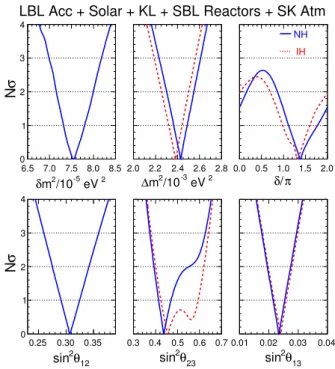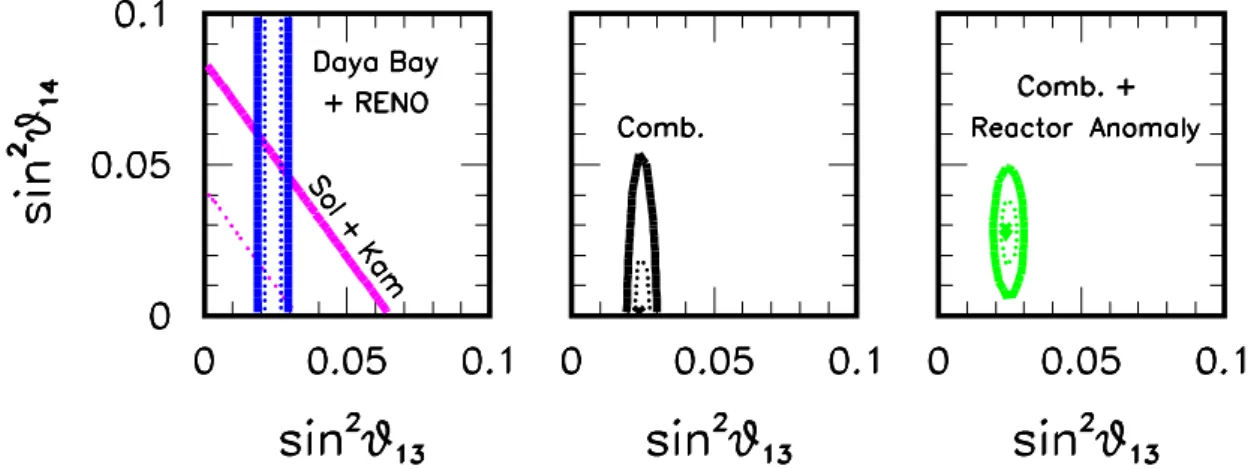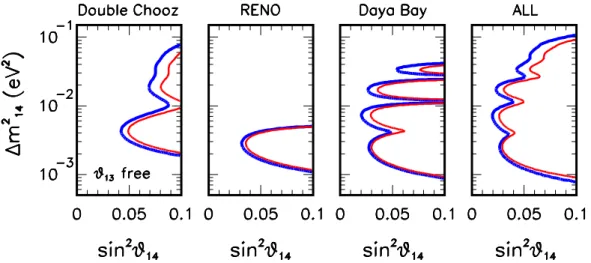Download details:
IP Address: 134.107.3.200
This content was downloaded on 06/03/2015 at 12:50
Please note that terms and conditions apply.
View the table of contents for this issue, or go to the journal homepage for more 2014 J. Phys.: Conf. Ser. 556 012062
(http://iopscience.iop.org/1742-6596/556/1/012062)
Theory of oscillations and sterile neutrinos
Antonio Palazzo
Max-Planck-Institut f¨ur Physik (Werner Heisenberg Institut), F¨ohringer Ring 6, 80805 M¨unchen, Germany
E-mail: palazzo@mpp.mpg.de
Abstract. We present a concise review of the theoretical status of neutrino oscillations within the (standard) 3-flavor framework and the (non-standard) 4-flavor scheme endowed with one additional sterile species (the so-called 3+1 scheme). We emphasize the slight overall preference that recently emerged for CP-violation in the 3-flavor analysis and highlight the unique role of the global data combination in the near future. After a brief introduction of the motivations for light (eV) sterile neutrinos, we discuss the bounds on their mixing with the electron neutrinos, attainable from the solar sector. The upper limit so obtained is independent of the reactor neutrino fluxes, whose calculations are affected by systematic uncertainties not completely under control. Finally, we highlight the possibility to explore sub-eV “super-light” sterile neutrinos exploiting theθ13-dedicated reactor experiments also commenting on the robustness of the 3- flavor results within the enlarged 3+1 scheme.
1. Introduction
Neutrino physics is living one of its most exciting epochs due to the recent observation of a relatively large value of the third mixing angle
θ13. This discovery provides concrete hopes of completing the description of the 3-flavor framework with the determination of the leptonic CP- violation (CPV) and the neutrino-mass-hierarchy (NMH). But the field of neutrino physics may even open the way to unexpected avenues. The neutrino sector may be richer than commonly believed and not confined to the 3-flavor framework. Several anomalies have recently emerged both in laboratory and cosmological data analyses, which already indicate some cracks in the standard 3-flavor picture, pointing towards new physics. New light sterile neutrinos may provide the solution of these puzzling results. In what follows, we present a concise review of the theoretical status of neutrino oscillations within the (standard) 3-flavor framework and the (non-standard) 4-flavor scheme endowed with one new additional sterile species (the so-called 3+1 scheme).
2. The 3-flavor paradigm
After many years of observations performed with atmospheric, solar, accelerator and reactor experiments, neutrino oscillations have been firmly established and the measurement of the mass-mixing properties is now entering a precision era. Except for a few results obtained in short-baseline (SBL) setups — on which we will return later — all the existing phenomenology is consistent with a simple 3-flavor scheme. In such a scenario, the three known flavor fields (ν
e,
νµ,
ντ) are mixed with the three mass ones (ν
1,
ν2,
ν3), through a unitary matrix
U(the so-called PMNS matrix). A common parameterization (adopted by the Particle Data Group [1])
Content from this work may be used under the terms of theCreative Commons Attribution 3.0 licence. Any further distribution
θ12
sin2 0.25 0.30 0.35 0
1 2 3 4
θ23
sin2
0.3 0.4 0.5 0.6 0.7
θ13
sin2
0.01 0.02 0.03 0.04
eV 2
/10-5
m2
δ
6.5 7.0 7.5 8.0 8.5 0
eV 2
/10-3
m2
∆
2.0 2.2 2.4 2.6 2.8
π / δ
0.0 0.5 1.0 1.5 2.0
σN
Figure 1.
Bounds on the oscillation parameters in terms of standard deviations Nσ from the best fit. Solid (dashed) lines refer to NH (IH). The horizontal dotted lines mark the 1σ, 2σ and 3σ levels for each parameter.
for such a matrix is
U=
R23Γ
δR13Γ
†δR12, where the
Rij’s are real Euler rotations with angles
θij ∈[0, π/2], while Γ
δ= diag(1, 1, e
iδ) embeds a Dirac CP-violating phase
δ∈[0, 2π].
2.1. Status of the 3-flavor parameters
The current neutrino phenomenology implies that the three-neutrino mass spectrum
{mi}i=1,2,3is formed by a “doublet” of relatively close states and by a third “lone” neutrino state. In the most frequently adopted labeling convention, the lightest (heaviest) neutrino in the doublet is called
ν1(ν
2) and the corresponding squared-mass difference is defined as
δm2=
m22−m21 >0.
Thanks to solar neutrinos, and more precisely to the matter (MSW) effects involved in the flavor conversion inside the sun, we know that the lightest eigenstate
ν1is the one having the larger superposition with the electron neutrino (|U
e1|2 '0.674,
|Ue2|2 '0.303). The lone state is labeled as
ν3and the sign of
m23−m21,2distinguishes two physically different cases. In one case, the mass spectrum is said to obey a “normal” ordering or hierarchy (NH) since, in this configuration, the lone state
ν3, which has a very small component of the electron neutrino flavor (|U
e3|2 '0.023) is the heaviest mass eigenstate. Conversely, in the other case, the lone state
ν3is the lightest mass eigenstate and the mass hierarchy is said to be inverted (IH). While the first case (NH) may naively seem more natural, both orderings are perfectly admissible and the one effectively realized in Nature must be determined through experiments. It is convenient to define the second independent larger squared-mass splitting as ∆m
2=
m23−(m
21+
m22)/2, so that the two hierarchies (NH and IH) are simply related by the transformation +∆m
2 → −∆m2. For phenomenological and historical reasons it is common practice to dub the
δm2-driven (∆m
2- driven) oscillations as the “solar” (“atmospheric”) flavor transitions.
Figure 1 displays the estimates of the mass-mixing parameters obtained by the global data analysis [2]. The plot shows the number of standard deviations Nσ from the best fit values. We have a good determination of the “solar” (δm
2, θ12) parameters (at the level of
2
2.6% and 5.4% respectively) and “atmospheric” (|∆m
2|, θ23) parameters (at the level of 2.9%
and 11% respectively). It is important to notice that while the (more precise) estimate of the two mass-splittings is currently dominated by the measurement of the frequency of the oscillation pattern(s) performed through “artificial” (reactor and accelerator) neutrino source experiments, the (less precise) estimate of the two large mixing angles (θ
12, θ23) — directly related to the amplitude of the oscillations — is determined by an interplay of “natural” (solar and atmospheric) and “artificial” (reactor and accelerator) neutrino source measurements. The third mixing angle
θ13(often called “reactor angle”) has been determined to be non-zero in 2012 by the three dedicated reactor experiments Daya Bay, Double-Chooz and RENO and by the accelerator experiment T2K, which have confirmed earlier indications coming from global analyses [3] (see also [4, 5, 6]). The current estimate of
θ13is dominated by Daya-Bay and the uncertainty on this parameter is
∼8%. Paradoxically, among the three mixing angles, the atmospheric one (θ
23), which was the first to be measured, is currently the least well-known.
In particular, it is not known if it is maximal or not and at the moment there is no robust indication in favor of any of two octants. Indeed, in our preliminary analysis (not shown) including the results presented at the Neutrino 2014 conference the slight preference for the first octant evident in Fig. 1 tends to decrease. In contrast, the same preliminary analysis confirms the weak preference (slightly below the 90% C.L.) for a non-zero value of the CP-violating phase
δ ∼ −π/2 apparent in Fig. 1. The current analysis is insensitive to the neutrino mass hierarchy.2.2. Importance of the leptonic CP-violating phase
δThe determination of the CP-violating phase
δis important per se as it would complete our knowledge of the electroweak interactions, complementing the relevant information coming from the quark sector. But the discovery of the leptonic CPV may have other and far reaching implications. In particular, it may have some role in leptogenesis, and therefore it may be linked to the origin of the matter-antimatter asymmetry of our Universe (see below).
In the PMNS matrix, the imaginary parts of all the quartic products
UαiUαj∗ Uβi∗Uβjare equal up to a sign and related by antisymmetric (in both flavor and mass indexes) coefficients
=[UαiUαj∗ Uβi∗Uβj
]
≡J Xγ=e,µ,τ
X
k=1,2,3
αβγijk.
(1)
where
Jis the so-called Jarlskog invariant, which gives a parameterization-independent measure of CP violation [7]. In the usual parametrization, one finds the expression
J
=
c12s12c23s23c213s13sin
δ ≡Jmaxsin
δ ,(2) where
cij ≡cos
θijand
sij ≡sin
θij. From (2) one realizes that CP-violation can occur only if all the three mixing angles are different from zero. Using the current best fit values of the three mixing angles one derives
Jmax'
3.0
×10
−2,(3)
which is not far from the maximum value theoretically attainable 1/6
√3
'0.1 (see [8]). The value of
δ ∼ −π/2 currently preferred by data implies a best fit Jbest ' −3×10
−2. It is interesting to make a comparison with the quark sector, in which case the Jarlskog invariant has been precisely determined and is
JCKM '3
×10
−5[1]. Therefore, we see that in the eventuality of confirmation of the current preference for
δ ' −π/2, the lepton sector would be asource of CP-violation three orders of magnitude larger than that provided by the quark sector.
Interestingly, the current best estimates of
θ13and
δsatisfy the inequality
|
sin
θ13sin
δ| '0.15
>0.11
,(4)
which is the condition for a successful leptogenesis having as the sole source of CP-violation the
Dirac phase
δ[9].
impossible) for a single experiment to provide definitive information (say an evidence at the 3 sigma level) for any of the two searched properties CPV and NMH. Rather, each experiment will (in the best case) provide some hint with low statistical significance. In this situation, it is clear that the combination of all the available data will be a powerful tool enabling us to get the most from the neutrino data. Important synergies can manifest only at the level of the global combination, where parameter degeneracies affecting the single datasets may be reduced.
Last but not least, the global analyses will test the mutual consistency of different pieces of data possibly evidencing discrepancies, which may be the harbingers of new physics beyond the Standard Model.
3. Light (eV) and super-light (sub-eV) sterile neutrinos
Several anomalies have recently emerged in short baseline (SBL) oscillation experiments, which indicate some “cracks” in the standard picture and point towards the existence of new physics. These are the LSND and MiniBooNE anomalies and the so-called “reactor and gallium anomalies”. Furthermore, the latest cosmological data suggests an excess in the radiation content of the Universe (the so-called “dark radiation anomaly”).
An intriguing hypothesis is that new light sterile neutrino species — Standard Model gauge singlets with mass of O(eV) — may be responsible for such inconsistencies, although they seem unable to provide a completely convincing explanation (see [10] for a critical discussion). Right- handed neutrinos appear in many extensions of the Standard Model, usually in the context of see-saw mechanisms, where their natural mass scale lies at the GUT energies. However, it is safe to affirm that the mass of these particles cannot be predicted in a robust way, and indeed it is not uncommon to find models accommodating lower masses down to the sub-eV domain.
3.1. An independent test of the low-energy anomalies
As mentioned above, a consistent interpretation of the anomalous results in terms of sterile neutrino oscillations is problematic. The most important difficulty is related to the tension (arising in all schemes with extra sterile neutrinos) among the
νµ→νeappearance results and the (joint
νe → νeand
νµ → νµ) disappearance searches (see [10]). In this perspective, it is essential to carefully put under test any single piece of evidence, irrespective of all the others.
Here, we focus on the reactor and gallium anomalies, which taken alone are fully consistent with a non-zero admixture of the electron neutrino with new sterile species, favoring the range
|Ue4|2∼
[0.020, 0.060] at the 2σ level [11] (see also [12]).
As we have shown in [13], where we have presented the analytical treatment of the solar MSW transitions in a general 3+s scheme, the solar sector data (Solar and KamLAND) offer a sensitive probe of such an admixture. In a subsequent paper [14], we have shown how the first evidence for non-zero
θ13(coming a that time only from Double-CHOOZ and T2K) further improved the sensitivity of the solar sector to
Ue4. In these proceedings we present an updated version of the analysis performed in [14] by incorporating the more recent (strongest) constraints on
θ13, which is now known with far better precision.
In the left panel of Fig. 2, the diagonal bands indicate the region allowed by the combined solar and KamLAND data in the plane [sin
2θ13,sin
2θ14]. We recall that in the parametrization adopted in [13, 14] it is
Ue42 ≡sin
2θ14. We stress that the KamLAND analysis has been
4
Figure 2.
Left panel: regions allowed by the solar sector data (diagonal bands) and by the dual- baseline reactor (Daya Bay and RENO) experiments (vertical bands). Middle panel: regions allowed by their combination. Right panel: combination of the constraints in the middle panel with those coming from the reactor anomaly taken from [11]. The contours refer to ∆χ
2= 1 (dotted line) and ∆χ
2= 4 (solid line).
performed using only the spectral shape information so as to render its results independent of the reactor antineutrino flux normalization. In the same panel, the vertical bands identify the range allowed for
θ13by the combination of the dual-baseline reactor experiments Daya Bay and RENO. The superposition of the regions allowed by the two datasets (solar+KamLAND and Daya Bay+RENO) evidences their complementarity in constraining the two mixing angles.
Their combination, shown in the central panel of Fig. 2, leads to the strong upper bound sin
2θ14≡ |Ue42 |<0.041 (90% C.L.)
.(5) As already stressed, this bound does not depend on the normalization of the reactor fluxes and thus represents an independent constraint on
|Ue4|2. Therefore, it makes sense to combine such a bound with the information coming from the reactor anomaly. The result of such an exercise is shown in the right panel of Fig. 2, where we have taken the reactor anomaly likelihood from [11]. The effect of the bound in Eq. (5) is a downshift of the 2σ range allowed for
|Ue4|2from [0.011, 0.054] to [0.005, 0.050], and a sensitive reduction of the overall statistical significance (from
∼3σ to
∼2.5σ) of the indication of
θ14>0.
3.2. Probing super-light sterile neutrinos at reactor
θ13-dedicated experiments
Three dedicated reactor experiments, Daya Bay, Double Chooz and RENO, have recently performed a precision measurement of the third standard mixing angle
θ13exploiting a multiple baseline comparison of
νe→νedisappearance driven by the atmospheric mass-squared splitting.
In [15] we have shown how the same technique can be used to put stringent limits on the oscillations of the electron neutrino into a fourth “super-light” sterile species characterized by a mass-squared difference lying in the range [10
−3−10
−1] eV
2. Here, due to space limitations, we only present the results of the analysis obtained in [15], referring the reader to the original work for more details. Figure 3 displays the constraints on the admixture
|Ue4|2obtained by a general 4-flavor analysis, in which
θ13is marginalized away.
The comparison of the first three panels evidences the complementarity of the three
experiments induced by the different baselines involved in the three setups. Hence, in the more
complicated 4-flavor scenario, in contrast to the simpler 3-flavor scheme, the fit is not dominated
by the sole experiment Daya Bay. Very recently, the Daya Bay collaboration has presented the
Figure 3.
Results obtained from the 4-flavor analysis. The contours refer to 2 d.o.f. 90% C.L.
(blue thick line) and 99% (red thin line).
first results of a 4-flavor analysis [16]. Unlike our study, which could make use only of the total rate information, Daya Bay exploits the full spectral information, obtaining more stringent constraints. We close this discussion on light sterile neutrinos with a final important remark.
As we have shown in [15], the estimate of
θ13obtained by the combination of the three reactor experiments is substantially independent of the new mass-squared splitting provided that this is not too low (> 6
×10
−3eV
2). Therefore, the 3-flavor picture is robust with respect to the perturbations induced by a fourth neutrino.
Acknowledgments
I would like to thank Cristina Lazzeroni and co-organizers for inviting me to this very interesting and enjoyable conference and for their kind hospitality in Birmingham. I acknowledge support from the European Community through a Marie Curie IntraEuropean Fellowship, grant agreement no. PIEF-GA-2011-299582, “On the Trails of New Neutrino Properties”. I also acknowledge partial support from the European Union FP7 ITN Invisibles (Marie Curie Actions, PITN-GA-2011-289442).
References
[1] Beringer Jet al[Particle Data Group Collaboration] 2012Phys. Rev.D86010001
[2] Capozzi F, Fogli G L, Lisi E, Marrone A, Montanino D and Palazzo A 2014Phys. Rev.D89093018 [3] Fogli G L, Lisi E, Marrone A, Palazzo A and Rotunno A M 2008Phys. Rev. Lett.101141801 [4] Balantekin A B and Yilmaz D 2008J. Phys.G35, 075007
[5] Schwetz T, Tortola M and Valle J W F 2011New J. Phys.13 063004
[6] Gonzalez-Garcia M C, Maltoni M and Salvado J 2010J. High Energy Phys.JHEP04 (2010) 056 [7] Jarlskog C 1985Phys. Rev. Lett.551039
[8] Giunti C and Kim C W 2007Fundamentals of Neutrino Physics and Astrophysics (Oxford University Press) [9] Pascoli S, Petcov S T and Riotto A 2007Nucl. Phys.B7741
[10] Palazzo A 2013Mod. Phys. Lett.A281330004
[11] Giunti C, Laveder M, Li Y F, Liu Q Y and Long H W 2012Phys. Rev.D86113014 [12] Mention Get al2011Phys. Rev.D83, 073006
[13] Palazzo A 2011Phys. Rev.D83113013 [14] Palazzo A 2012Phys. Rev.D85077301
[15] Palazzo AJ. High Energy Phys.JHEP10 (2013) 172
[16] An F Pet al[DAYA-BAY Collaboration] 2014Phys. Rev. Lett.113141802
6


